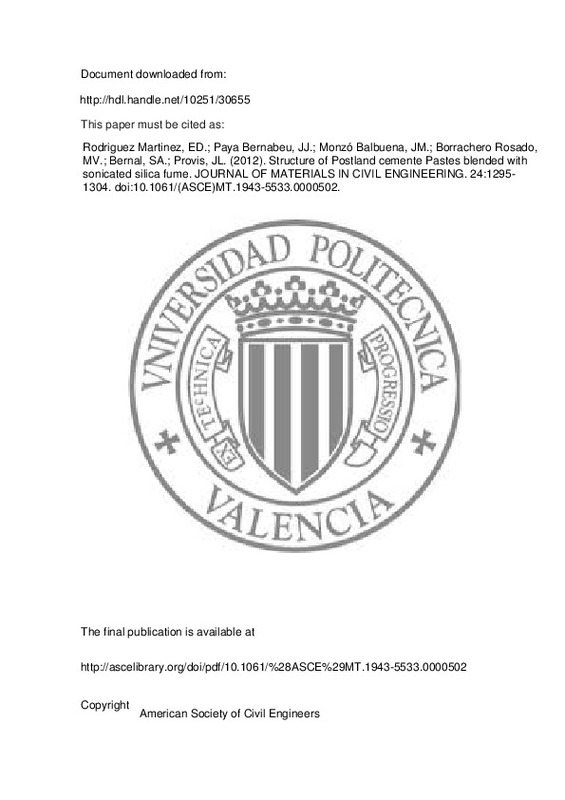Rodriguez Martinez, ED.; Bernal, SA.; Provis, JL.; Paya Bernabeu, JJ.; Monzó Balbuena, JM.; Borrachero Rosado, MV. (2012). Structure of Portland Cement Pastes Blended with Sonicated Silica Fume. Journal of Materials in Civil Engineering. 24:1295-1304. https://doi.org/10.1061/(ASCE)MT.1943-5533.0000502
Por favor, use este identificador para citar o enlazar este ítem: http://hdl.handle.net/10251/30655
|
Título:
|
Structure of Portland Cement Pastes Blended with Sonicated Silica Fume
|
|
Autor:
|
Rodriguez Martinez, Erich David
Bernal, Susan A.
Provis, John L.

 Paya Bernabeu, Jorge Juan
Paya Bernabeu, Jorge Juan

 Monzó Balbuena, José Mª
Monzó Balbuena, José Mª

 Borrachero Rosado, María Victoria
Borrachero Rosado, María Victoria
|
|
Entidad UPV:
|
Universitat Politècnica de València. Departamento de Ingeniería de la Construcción y de Proyectos de Ingeniería Civil - Departament d'Enginyeria de la Construcció i de Projectes d'Enginyeria Civil
Universitat Politècnica de València. Instituto de Ciencia y Tecnología del Hormigón - Institut de Ciència i Tecnologia del Formigó
|
|
Fecha difusión:
|
|
|
Resumen:
|
[EN] Application of power ultrasound to enhance dispersion of commercial densified silica fume leads to increased compressive
strengths and refinement of the pore structure in mortars, compared with those that are ...[+]
[EN] Application of power ultrasound to enhance dispersion of commercial densified silica fume leads to increased compressive
strengths and refinement of the pore structure in mortars, compared with those that are untreated. This was attributed to the enhanced
pozzolanic reactivity achieved by particle dispersion through sonication, leading to higher consumption of portlandite during curing,
and formation of a calcium silicate hydrate gel with a higher degree of cross-linking than is identified in specimens with densified silica
fume. This suggests that with the use of sonicated silica fume, it is possible to reduce the required quantity of admixture in blended cements to
achieve specified performance, with the additional advantage of the formation of a highly densified structure and refined pore network,
contributing to potential improvements in durability.
[-]
|
|
Palabras clave:
|
Silica fume
,
Sonication
,
Portland cement
,
Calcium silicate hydrate
,
Pozzolan.
|
|
Derechos de uso:
|
Reserva de todos los derechos
|
|
Fuente:
|
Journal of Materials in Civil Engineering. (issn:
0899-1561
) (eissn:
1943-5533
)
|
|
DOI:
|
10.1061/(ASCE)MT.1943-5533.0000502
|
|
Editorial:
|
American Society of Civil Engineers
|
|
Versión del editor:
|
http://ascelibrary.org/doi/pdf/10.1061/%28ASCE%29MT.1943-5533.0000502
|
|
Código del Proyecto:
|
info:eu-repo/grantAgreement/MEC//BIA2007-63252/ES/ACTIVACION DEL HUMO DE SILICE MEDIANTE TECNICAS DE ULTRASONIDOS PARA EL DESARROLLO DE NUEVOS CONGLOMERANTES EN EL CAMPO DE LA CONSTRUCCION/
info:eu-repo/grantAgreement/MICINN//BES-2008-002440/ES/BES-2008-002440/ /
info:eu-repo/grantAgreement/MICINN//EEBB-2011-43847/
|
|
Agradecimientos:
|
This study was sponsored by the Ministerio de Ciencia e Innovacion of Spain (Project SILISONIC BIA-2007-63252 and research scholarships BES-2008-002440 and EEBB-2011-43847), the European regional development fund (FEDER), ...[+]
This study was sponsored by the Ministerio de Ciencia e Innovacion of Spain (Project SILISONIC BIA-2007-63252 and research scholarships BES-2008-002440 and EEBB-2011-43847), the European regional development fund (FEDER), and the Universitat Politecnica de Valencia (Spain). Participation of SAB and JLP was funded by the Australian Research Council (ARC), including partial funding through the Particulate Fluids Processing Centre, a Special Research Centre of the ARC. The authors thank Dr. John Gehman for support in conducting the NMR experiments at the Bio21 Institute, University of Melbourne, Australia.
[-]
|
|
Tipo:
|
Artículo
|







![[Cerrado]](/themes/UPV/images/candado.png)


